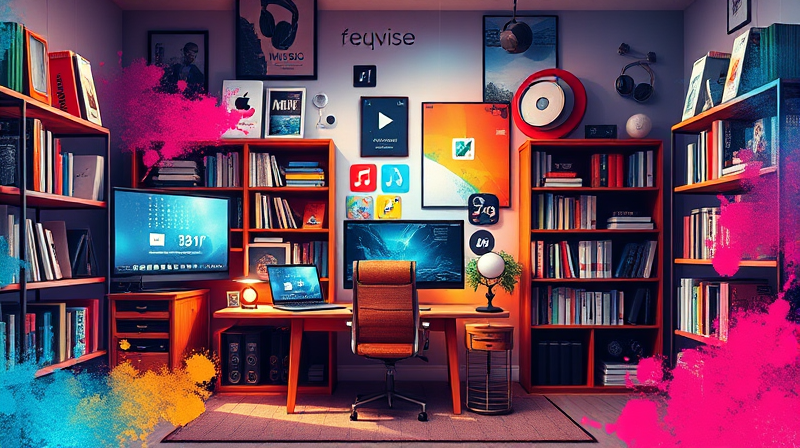Creating a personal media library in today’s digital age goes beyond the simple act of accumulating content. It is an inspiring journey of self-expression and organization. When you take the time to build a collection that reflects your interests, passions, and personality, you are not only preserving memories and experiences, but you are also constructing a living digital archive of who you are. Every piece of media carries a part of your story and contributes to a narrative that only you can tell.
In 2025, modern tools and evolving platforms have made it easier than ever to design a media library tailored to your needs. With innovative services and intuitive organizational methods, you can now curate collections that are as dynamic and unique as your personality. This article walks you through the inspiring process of building a personal media library that truly reflects you.
Defining Your Media Identity
Before you start gathering files and organizing folders, take a moment to reflect on what media truly speaks to you. Are you passionate about classic movies, drawn to independent music, or an enthusiast of thought-provoking podcasts? Identifying your preferences is the crucial first step in forming a media identity that is authentic and reflects your personal taste.
Create a mental or digital list of themes and genres that resonate with you. This initial step lays the foundation for what will result in a well-curated, inspiring library that is not only functional but also deeply personal.
Organization Is the Key to a Seamless Experience
A media library that is well-organized transforms into a haven of easy navigation and accessibility. Grouping your files by type—be it movies, TV shows, music, audiobooks, or podcasts—will provide clarity and simplicity in retrieving your future favorites.
Simple practices such as dedicated folders can make all the difference. Create folders like "/Movies", "/Music", "/Books", and "/Podcasts", and further subdivide them using subcategories or genres. Adopting consistent naming conventions, like using the release date for movies or episode numbers for shows, helps streamline search functions and ensures your collection is both neat and useful.
Consider these steps to optimize your organizational structure:
- Establish clear file paths to avoid misplacement.
- Utilize tagging systems to create a searchable network within your library.
- Maintain regular backups to secure your content against data loss.
By implementing these practices, you not only improve performance but also add a professional touch to your personal collection.
Embracing Modern Tools and Features
One of the most exciting aspects of building a media library today is the variety of modern tools at your disposal. Platforms such as Plex are revolutionizing the way we manage and interact with digital content. Plex and similar media server solutions not only organize and manage files automatically but also offer customization options that lend your library a unique, personal flair.
Customization plays a major role in enhancing your media library. Choose custom posters, fan art, or even design theme playlists that speak to your style. These touches ensure that every time you log in, your media collection feels like an extension of your personality and creativity.
Optimizing for Performance and Accessibility
A well-curated media library is not just about aesthetics—it also needs to perform efficiently. Optimizing your files by compressing them can significantly improve load times and overall system performance. Additionally, regular audits of your collection will help in identifying and removing duplicate or unused files, leading to a clutter-free space.
Think of your media library as an evolving entity. Continuous updates and improvements are essential. As new media is added, old files should be periodically reviewed to ensure that your digital archive remains fresh, relevant, and easy to navigate.
Utilizing Sorting and Search Features
As your collection grows, the importance of effective filtering and search capabilities becomes paramount. Digital platforms today offer robust features such as list view modes, date filters, and full tag systems that help in quickly locating the content you’re in the mood for.
By setting up these systems from the start, you ensure that every time you use your library, exploring becomes a delightful and efficient experience. Consistency in naming and organizing your files makes the searching process almost effortless, allowing you to reach the content you desire with just a few clicks.
Showcasing and Sharing Your Digital Archive
The digital revolution has made connectivity easier than ever. If you feel inclined to share your passion beyond your own private collection, consider how your media can inspire others. Social platforms, especially those that thrive on digital content like YouTube Shorts, offer exciting avenues to present highlights or themed collections from your library.
Always bear in mind that each shared piece is an opportunity to express a part of your identity to a broader audience. Creating visually appealing content that reflects your style not only promotes your media but also encourages like-minded enthusiasts to embark on their own curatorial adventures.
Maintaining the Heartbeat of Your Library
Over time, your interests might shift, and new passions will emerge. Regularly scheduled reviews of your media collection will help you stay in tune with your evolving tastes. Plan for periodic curation sessions where you update details, change out artwork, or reorganize the files to mirror any new directions your interests might take.
This commitment to update and refine your library makes it a living entity that grows along with you. The beauty of a personal media collection lies in its ability to mirror your life's journey, every phase enriched by new experiences and inspirations.
In conclusion, curating a personal media library is a creative endeavor that is as much about technical organization as it is about self-expression. Whether you are a dedicated cinephile, a music aficionado, or someone who simply loves collecting inspirational content, the journey to create your digital archive should be a reflection of who you are. Embrace the process, stay consistent with your organizational practices, and let your media collection tell your unique story—one file at a time.
Remember, every time you add a new piece to your collection, you are not just storing data; you are curating a piece of your personal history that can inspire and motivate for years to come.








